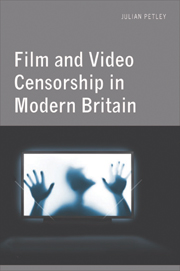Part II - After the Deluge
Published online by Cambridge University Press: 05 August 2013
Summary
The chapters in Part II of this book take up the story of video, and to a lesser extent, film, censorship in the wake of the passing of the Video Recordings Act 1984. They usefully illustrate the extent to which the fears of the critics of the Act aired in Part I were, and weren't, justified, but what gives them their particular interest is the light which they throw on the modus operandi of the BBFC's remarkable Director, James Ferman.
Ferman had been appointed as the Secretary of what was then the British Board of Film Censors in 1975, an extremely difficult time for the institution. In 1971 the wily and diplomatically skilled John Trevelyan finally stepped down as Secretary and was replaced by the less affable and canny Stephen Murphy. During his time the Board was almost constantly assaulted by the Whitehouse brigade, angry politicians and censorious newspapers for passing films such as The Devils, Straw Dogs, A Clockwork Orange and Last Tango in Paris, albeit with cuts in most cases. Indeed, so alarmed was the Cinematograph Exhibitors' Association by the odium being heaped on its members for showing these kinds of films that its President publicly called for Murphy to step down. (Useful accounts of this period of turmoil for the Board can be found in Mathews 1994: 189–215, and Robertson 1989: 134–57.) Essentially Ferman was appointed by the BBFC President Lord Harlech to reform the Board and to restore its credibility, which he did remarkably successfully.
- Type
- Chapter
- Information
- Film and Video Censorship in Modern Britain , pp. 49 - 54Publisher: Edinburgh University PressPrint publication year: 2011



